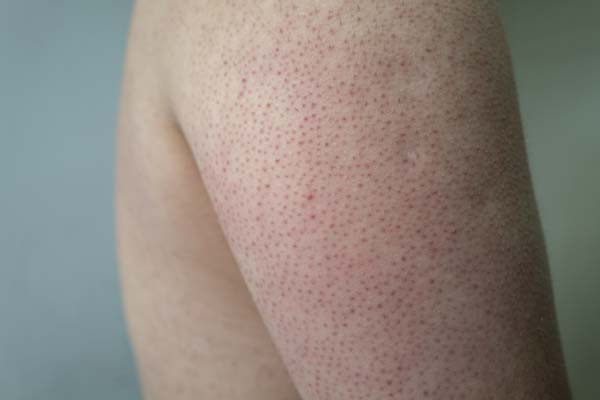Keratosis pilaris: Treatment and self-care for this common skin condition
- Reviewed by Howard E. LeWine, MD, Chief Medical Editor, Harvard Health Publishing; Editorial Advisory Board Member, Harvard Health Publishing

Have you or your child ever experienced rough, bumpy "chicken skin" on the upper arms and thighs? You are not alone. It is estimated that 50% to 80% of teens and 40% of adults are affected by this common, harmless skin condition known as keratosis pilaris.
Keratosis pilaris symptoms and causes
Keratosis pilaris is characterized by the development of small red or flesh-colored bumps that give the skin the appearance of "gooseflesh." The bumps most commonly develop on the outside of the upper arms and tops of the thighs but may also be seen on the face, cheeks, and buttocks. Other common symptoms include:
- redness of the skin surrounding the bumps
- rough skin texture
- dry skin
- mild itching.
Keratosis pilaris usually appears during childhood or adolescence, and gradually improves with age.
The cause of keratosis pilaris is not fully understood. It is thought to be caused by a genetic mutation in a protein called filaggrin, which causes the skin to produce too much keratin, the most abundant protein in our skin, hair, and nails. Excess keratin plugs the hair follicles on the skin, which is what causes the characteristic bumps seen in keratosis pilaris. The condition often runs in families. It is also commonly seen in people who have a history of eczema and dry skin.
Keratosis pilaris treatment options
While treatment can help diminish the appearance of the characteristic bumps, don't expect any treatment to rapidly clear it.
There are both over-the-counter and prescription medications available. For example:
- topical preparations containing lactic acid, ammonium lactate, salicylic acid, urea, or a combination of these ingredients. Topical treatments are applied to the skin.
- topical retinoids such as tretinoin and adapalene
- topical steroids to help with redness or itching
- laser therapies.
It may take weeks of consistent treatment before you notice an improvement. Treatments should be continued even if your condition improves, to prevent recurrence. The only exception to this is the use of topical steroids including hydrocortisone. Topical steroids should only be used once or twice daily for no more than one to two weeks, unless prescribed differently by a clinician.
Most often, keratosis pilaris will improve and lessen with time and age.
Self-care for managing keratosis pilaris
Keratosis pilaris tends to be worse in the dry winter months. It can also be worsened by clothing that is too tight or too thick and causes friction with the affected areas.
Self-care tips to improve the appearance of keratosis pilaris include:
- Moisturize your skin daily with a non-fragranced, cream-based moisturizer.
- Avoid thick, tight, or abrasive clothing such as wool or spandex.
- Opt for soap-free body cleansers in place of harsh soaps on the affected skin.
- Avoid hot and prolonged baths and showers, which can dry out the skin.
- Do not pick at the bumps.
- Use a humidifier.
The role of exfoliation in treating keratosis pilaris
Skin exfoliation is a mainstay of treatment for keratosis pilaris. Exfoliation refers to removing dead skin cells from the skin's surface. Exfoliation may be done physically or chemically; both methods smooth the skin surface and flatten the bumps. Exfoliants do not relieve the redness or itching that may be associated with keratosis pilaris.
Topical exfoliant preparations, known as keratolytics, are generally recommended because physical exfoliation (such as with a loofa) can cause further skin irritation if used too vigorously. Keratolytics contain ingredients such as lactic acid, ammonium lactate, salicylic acid, and urea, which act as chemical exfoliants and gradually smooth the skin.
All types of exfoliants can cause irritation if used too frequently. It is best to exfoliate two to three times weekly, and slowly increase over time as needed and as your skin becomes more accustomed to the treatment.
Reduce your use of exfoliants if your symptoms worsen or if you experience dryness, redness, rash, or irritation.
Distinguishing keratosis pilaris from other skin conditions
Keratosis pilaris has a similar appearance to other skin conditions including eczema, acne, and folliculitis. The following key features help distinguish keratosis pilaris from these other skin conditions:
- Itch. Keratosis pilaris can be itchy on occasion, but usually does not itch. If your skin is red, dry, and very itchy, it's more likely to be dry skin or eczema.
- Bumps. The classic bumps of keratosis pilaris are usually small (1 to 2 mm), numerous, and give a rough or spiny texture to the skin. If you have bumps that are larger, painful, felt beneath the skin, or pus-filled, you may have acne.
- Timing. Keratosis pilaris usually occurs during childhood or early adolescence, and gradually improves in your 20s and 30s. While the condition may worsen or improve with certain factors, it typically never completely goes away. If you experience a sudden onset of red bumps, particularly pus-filled bumps, most commonly after shaving, wearing tight clothing, or spending time in a hot tub, you may be experiencing folliculitis. Folliculitis results from irritation or infection of the hair follicles.
About the Author

Jennifer Fisher, MMSc, PA-C, Health Writer
About the Reviewer

Howard E. LeWine, MD, Chief Medical Editor, Harvard Health Publishing; Editorial Advisory Board Member, Harvard Health Publishing
Disclaimer:
As a service to our readers, Harvard Health Publishing provides access to our library of archived content. Please note the date of last review or update on all articles.
No content on this site, regardless of date, should ever be used as a substitute for direct medical advice from your doctor or other qualified clinician.















